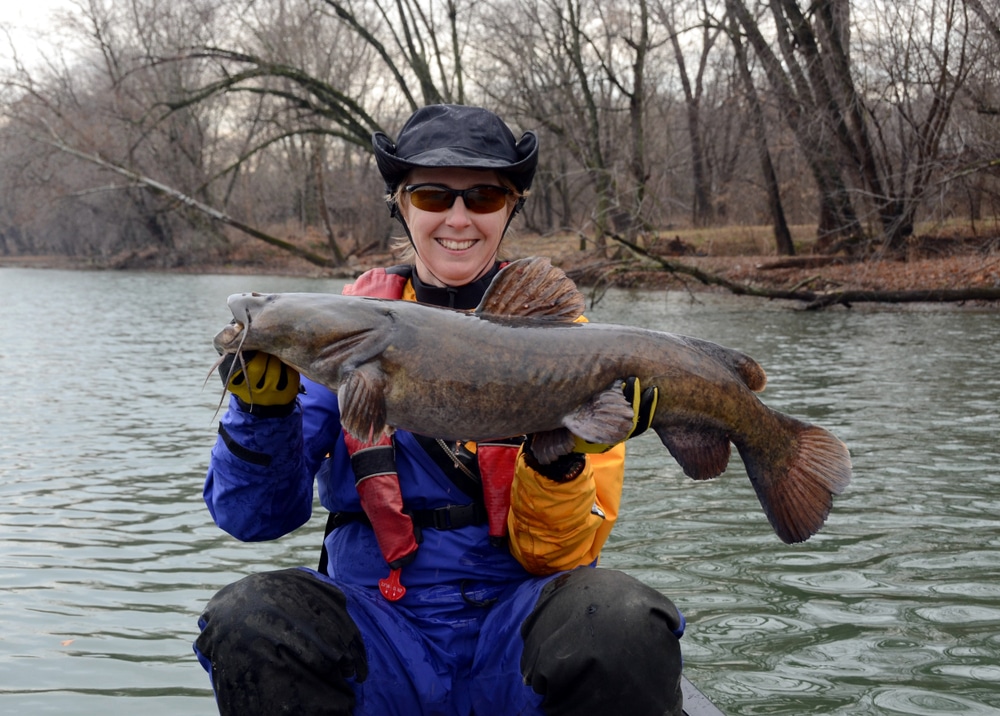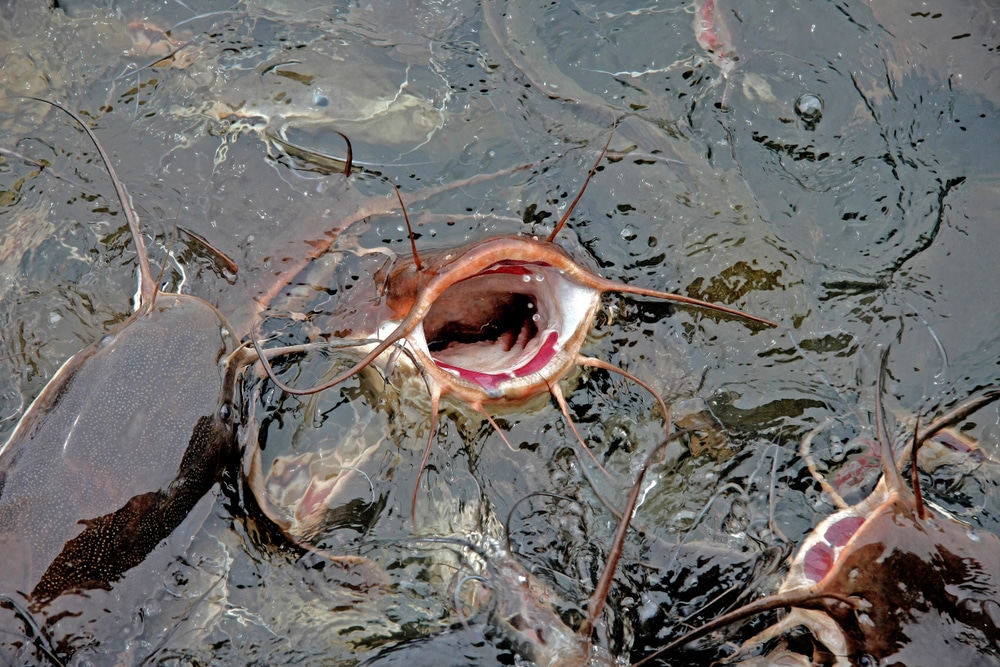There is a lot of arguing online about the type of rod you need to catch flathead catfish from shore.
Because of the variation in locations where you will find big flathead catfish, you want a long rod about 10 to 12 feet in length.
These are big fish, so you need a rod with heavy power; it needs to take a bigger weight to bend the rod.
You also need a rod with medium-heavy to heavy action.
Again, these are big fish, and you want to spread out their weight and fight along the entire rod.

Contents
Why a Long Rod Over a Short Rod?
The answer comes down to your ability to cast long, short, and medium distances with a heavy piece of bait on the line.
You will have better results with a longer rod over a shorter rod.
There are some situations where a long rod will not work well.
These include when you are having to cast from undercover, overhanging trees or if you are up next to a steep bank where you don’t have the room to fully extend the rod over your shoulder.
Except for situations where you cannot effectively use a long rod, your go-to rod should be 10-12 feet in length.
Some catfish anglers prefer to use a long surf rod, which should be able to handle the bigger catfish.
There are catfish rods available and if you have the budget for one, it is a good tool to own.
Start your flathead catfish rig setup with a big hook – 4/0 is a good starting point.
Hooks and circle hooks are the best option, can range in size from 4/0-8/0.
You’ve likely seen how large big catfish mouths are, so there is a good reason to go big with hook sizes.
Over 8/0 is overkill. There are whisker seeker hooks designed for catfish fishing. Those can be good options too.

Best Bait for big Flathead Catfish
Flathead catfish feed mostly at night and that is when you want to target them.
They leave the deeper water around sunset and enter shallow lagoons, pools, and bays to hunt for fish.
The best bait for them is live bait. And generally, that means bluegill or perch. Sunfish are also a good option.
Setting up A Rig for Big Flathead Catfish
The standard setup is a swivel connector, a sinker clip, an 6-8 ounce sinker, a short leader – 12-18 inches, a rattle spinner, a stack of beads and your hook.
That’s all you need to set up your rig for big Flathead catfish.
You connect your swivel to your main line, attach the sinker clip, and then the sinker to the sinker clip.
Tie your leader onto the bottom of the swivel, slide on your rattle, followed by 3-6 beads, and then your hook.
The beads act as a safeguard that protects the line where your hook is.
They also help to keep the hook in position so that nothing obscures a clean hook set. Alternatively, you can use a bullet weight and skip the sinker clip.
Picking a Spot
Picking the best spot to cast your bait is fairly easy if you follow a few general rules.
Understand that big Flathead catfish leave the deeper water as it starts to get dark.
They swim along the bottom and into shallow water.
What you want to look for varies depending on what kind of body of water you are fishing.
You want to look for places where the water narrows – such as smaller openings into bays.
These locations force all the fish to move from deep water into a smaller location as they enter the hunting grounds.
When you can naturally cause fish to congregate in smaller spaces, you have better odds of catching more fish.
Where to Drop Your Bait Depending on The Location
- Pond – Around islands, if there is one, a dock or ramp or along heavy weed patches.
- Lake – Rocky points that have shallow water on one side or the other. The smaller fish will be in the shallows and the catfish will be there hunting them. If you can visually detect an overhang, then that would be an ideal spot to target big catfish at night.
- River – Look for shallow water, overhangs, and places where the current is slowest. Inner bends are generally slower than outer bends, behind objects, such as big rocks, which slow the current and around fallen logs.
- Creek – Along weed beds, places where the river or creek narrow, sunken logs, and other places where small fish would hide.
What Is the Best Time to Fish for A Flathead?
It is not impossible to catch big flathead catfish during the day, but they are more active at night.
The best times to target flathead catfish is anywhere from an hour before sunset until a few hours after sunrise.
Catfish are slow, methodical hunters, so it takes them a while to feed.
Plan to fish all night long or hit the water at peak migration; when they are leaving or returning to the deeper water.
That is also why you want to drop bait in areas where the structure of the water forces them to travel through narrowing channels where they cannot help but find your bait.
How Do You Catch Flathead Catfish from Shore at Night?
The best way to catch flathead catfish from shore at night is to drop live bait in the correct location.
Catfish have poor eyesight, so they hunt by their sense of smell and by following vibrations in the water.
Flathead catfish hunt in shallow water for smaller fish, crustaceans, turtles, and even other catfish.
You want to set up your line rigging to include a rattle spinner, which will add to the vibrations allowing the catfish to hone in on your hook.
Using live bait is also a good option and bluegill, perch, and sunfish are three of your best options.
Find a good location in the shallows, and cast your line, bait, and sinker out where there is some sort of structure.
That can mean a narrow inlet, an overhanging bank, or near a sunken log or weed patch.
Catfish are not heavy striking fish, meaning you may not feel a tug on the line.
You may notice that your line starts to strip off the reel or that it begins to drift at a weird angler from the tip of the pole.
Both situations indicate that something has taken your bait and is moving off.
Set the hook and keep the rod tip in the air. A big catfish will bend your rod to near breaking with deep arcs in the rod.
Bigger catfish will wear you out but stick with it.
Lift and reel in the line, and be ready with a dip net to remove the fish from the water.
How Do You Catch Flathead Catfish from Shore in Winter?
The process of shore fishing for big flathead catfish in winter is the same as described above, with a little variation.
If you are fishing in ice-free water, fish like you would normally.
If you are ice fishing for flathead catfish you will want to pay close attention to their habits.
Set your ice hut up and drill the ice in two spots several hours before you plan to fish.
The auger’s noise and vibration will scare the fish away, and you will have access to fewer catfish.
By setting up early, the smaller food-fish will return and when the sun starts to sink, the flatheads will show up to hunt.
You still want to fish with live bait or something that leaves a scent trail.
Flatheads are opportunistic hunters and will make a meal of whatever they can find.
They prefer live baits to cut bait, but people do catch flatheads on cut bait.
If you are fishing for big flatheads under the ice, you will need to adjust the length of your rod to one that you can manage inside the hut.
Since you are not casting, the length is not important.
You still want a rod that has heavy power and heavy action and one that is rated to handle big fish.
The best time to fish for flathead catfish in winter is again from sunset to sunrise.
These fish are more active at night than they are during the day.
The best locations include areas where the natural lay of the land causes the fish to bunch in the shallow water.
My ideal spot for shore fishing for flatheads is any place that offers access to shallow water and that has a narrow opening.
A narrow spot in a river or creek, a narrow opening, or an inlet to a bay.
A good tip if you are new to fishing for flatheads is to bring a lot of live bait.
To catch a lot of bluegills, perch, or sunfish use little net balls of sweet corn.
All three of these live baits cannot resist sweet corn.
You can tie your own net balls using netting and thread or you can sometimes find net balls all ready to use at your local bait store.
Whatever you do, don’t be surprised how long this species can stay alive, especially out of water.







